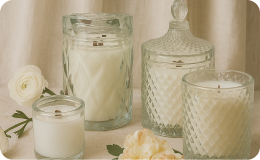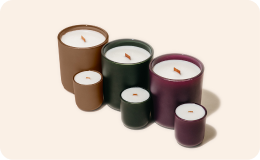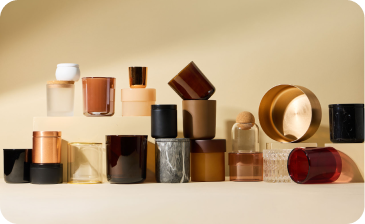Glossary of Soap Making Terms
Learning to make soap means learning a whole new language about soap as well! Familiarizing yourself with soap making terms is necessary, and while there are a lot of them, you’ll find yourself quickly throwing them around as if you’ve always known them!
base
A curated blend of ingredients that provide specific benefits for your finished soap product. The base (or base oils) are the foundation to your recipe that can then be built upon.
caustic
If something is deemed caustic, it has the ability to corrode or destroy other materials via chemical reaction. Including your skin! Caustic materials must be handled with caution.
cold process
The process in which saponification occurs without using an external heat source. In cold process soap making, the heat comes as a result of mixing oils with lye to induce the saponification process through chemical reaction.
curing
Last step of soap making process where excess water evaporates, leaving a firm and dry final soap product.
emollients
Ingredients that help to moisturize, soothe and soften the skin. The definition of emollients is to make something soft and supple. Emollients include oils, butters, and waxes.
essential oil
Natural extracted oils taken from a single plant or flower species through various types of distillation processes.
false trace
When the combination of oils, lye and water emulsify and thicken too quickly in the soap making process. This is often caused by the solid oil temperature changing too quickly, creating the look of saponified oils.
flash point
The lowest temperature at which an oil will “flash” or ignite if met with a fire source or flame.
fragrance oil
Lab created aromas using natural, synthetic and essential oil combinations. Fragrance oils can mirror scents from nature or can be uniquely curated scents.
gelling
Stage at which the soap heats up during saponification enough to visibly change the appearance to a gel-like substance. Typically gelling starts in the middle of your soap loaf and then spreads out to the edges.
glycerin
A skin moisturizing emollient and natural humectant which occurs as a result of the soap making process.
glycerin rivers
A result due to too much heat during the saponification process where the glycerin does not disperse throughout the soap, but instead congiles causing a translucent marbling effect.
hand milled or rebatch
Soap made from soap scraps or “failure” batches. This soap has already gone through saponification and lye is not needed. Hand milled soap only takes a few hours to make, but requires several weeks to cure. It is more difficult to get consistent results with this technique and the final product may appear lumpy.
hot process soap
The process in which saponification occurs by using an external heat source to expedite this part of the process such as a crockpot or melter.
inci
The INCI listings on products are standardized ingredient names spanning across the global personal care market. INCI acronym stands for International Nomenclature Cosmetic Ingredient.
lye
A alkali ingredient also called by its scientific names Sodium hydroxide (NaOh) and Potassium hydroxide (KOH). Lye is a necessary chemical compound in soap making and critical to the saponification process.
lye discount
Intentionally using less lye in the recipe to cause free floating oils in the final soap product. Also called “superfatting” (definition below).
melt and pour
Pre made soap base that is ready for use and has already been through the saponification and curing process.
melt point
Temperature at which a solid will begin to melt or liquify.
oils
Plant derived oils of various viscosities that contain fatty acids. Oils are a critical ingredient in any soap base because the saponification process could not happen without them.
ph
A scale from 0 to 14 that identifies the acidity or basicity of a liquid solution. pH testing is a necessary step for makers to confirm that their soap is skin safe and ready for use. Results showing a pH of 0 to 6 is acidic, pH 7 is neutral and pH 8 to 14 is alkaline.
potassium hydroxide (koh)
A type of lye used to make liquid soap. KOH can come in a variety of forms like pellets, flakes and powders.
ricing
Typically occurs when fragrance oil binds to a harder oil in the recipe, resulting in a rice-like texture change.
rspo palm
Acronym stands for Roundtable for Sustainable Palm Oil- a commission formed with the main objective of producing a sustainable palm oil product at the lowest possible impact to the environment.
saponification
Chemical reaction from when fats and oils are combined with lye to form soap. “Sapo” in Latin means “soap”, thus why the moment in which the batch turns (quite literally) to soap is called saponification.
sap value
Every base oil has a SAP value which indicates the amount of lye needed to induce the saponification process.
seizing
When soap becomes extremely thick quickly, causing it to be unworkable and unusable.
sodium hydroxide (NaOH)
A type of lye used to make cold process soap. NaOH can come in a variety of forms like pellets, flakes and powders. Sodium Hydroxide is also called Caustic Soda.
superfatting
Having more free floating oil in the finished soap product. There are two ways to achieve superfatting- using less lye in order to have leftover oils or by using more oil than the standard formula calls for. Either way, the result provides extra moisturizing benefits via oil.
trace
The beginning of the saponification process where oils, lye and water have emulsified together. The trace should start out at a thinner consistency and thicken over time.
trinity blend
Proprietary blend of coconut oil, RSPO palm oil and olive oil- the most amazing base for your soap! Coconut oil creates a fluffy lather that gently cleanses. Palm oil makes the blend cost-effective and adds hardness for a long-lasting bar. Olive oil is rich in fatty acids and antioxidants that add rich, moisturizing properties.
water discount
Using less water than in the soap recipe. Results in quicker curing time since there is less water that needs to evaporate during this part of the process.
common soap making acronyms
- B&B: bath and body
- CP: Cold Process
- DOS: Dreaded orange spots
- EO: Essential Oil
- FO: Fragrance Oil
- HP: Hot Process
- IFRA: International Fragrance Association (governs skin safety percentage of fragrances)
- KOH: Potassium hydroxide
- M&P: Melt & Pour
- MSDS: Material Safety Data Sheet
- NaOH: Sodium hydroxide
- OOB: out of the bottle
- PPE: personal protective equipment
- RT: Room temp
- SAP: Saponification values









